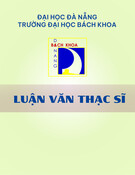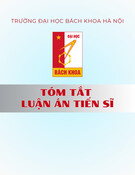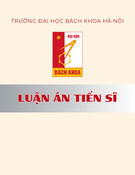
Physical Layer Signaling for the Next
Generation Mobile TV Standard
DVB-NGH
Author: José Mª Llorca Beltrán
Director: David Gómez Barquero
Tutor: Narcís Cardona Marcet
Start Date: 1/04/2010
Workplace: Mobile Communications Group of iTEAM


Physical Layer Signaling for the Next Generation Mobile TV Standard DVB-NGH 1
Objectives — This Master of Science degree thesis aims at investigating, studying and developing the new
physical layer for the new handled generation of terrestrial TV standard DVB-NGH. This new physical layer
is based on the DVB-T2 physical layer specification, but it introduces several advanced mechanisms to allow
the transmission of high definition TV services in mobile environments. The main objective of this thesis
work is focused on illustrating the benefits of the new physical layer when compared to T2 physical layer.
Methodology —A comparison study between the new standard and the previous DVB-T2 is carried out,
focusing on the adopted mechanisms and robustness enhancement techniques. Such study is performed by
simulating both DVB-T2 and DVB-NGH physical transmission chains in typical deployment scenarios.
Theoretical developments —The theoretical developments have been carried out following the
standardization process of DVB-NGH, where several proposals have been admitted and studied for
enhancing the NGH physical layer in different aspects, i.e. increasing the robustness, signaling capacity and
overhead reduction in comparison to the DVB-T2 physical layer.
Prototypes and lab tests — The DVB-T2 physical layer simulator has been developed according to the
standard and the DVB-NGH physical layer simulator has been programmed following the standardization
process, including all the approved proposals. Both simulators perform all the physical transmission chains
for DVB-T2 and DVB-NGH.
Results — The results shown in this work include performance curves, focusing on signaling robustness,
signaling capacity and overhead reduction. The DVB-NGH results have been compared to SAMSUNG‘s
(South Korea) in order to validate the robustness mechanisms in the standardization process of DVB-NGH.
The simulation results show a gain in robustness when adopting the DVB-NGH physical layer techniques
instead of DVB-T2. In addition, DVB-NGH improves signaling capacity and reduces the overhead.
Future work —The future work may be done by studying the effect of the signaling physical layer at
MIMO and SIMO environments. In addition, once the standardization process finalizes, another possible line
of investigation may be to study the most suitable configuration of L1 signaling for different mobile
transmission environments.
Publications — The contents and results of this thesis has been included in two technical reports on DVB-
NGH at the European R&D project ―ENGINES: Enabling Next GeneratIon NEtworks for broadcasting
Services‖:
Task Force TF1 ―System concept refinements for DVB-NGH‖- Technical Report TR 1.1
Intermediate Report on DVB-NGH Concept Studies. Section 3.1.2 L1 signaling robustness
improvement techniques, pp 36-48.
Task Force TF4 ―Hybrid access technologies‖ - Technical report TR4.1 Interim Report on
Hybrid Access Technologies. Section 4.5 L1 Signaling for the Hybrid Profile, pp 84-88.

2 Physical Layer Signaling for the Next Generation Mobile TV Standard DVB-NGH
Moreover, the enhancement studies of the physical layer signaling in DVB-T2 have been included in the
Implementation Guidelines of DVB-T2 in an updated version. This new version includes all the
developments since the Implementation Guidelines of DVB-T2 were published (i.e. T2-Lite). Our
contribution focused on the signaling path performance for different robustness types and modulations. The
study has been evaluated in different environments, SISO and SIMO, using the TU6 channel model with
Doppler frequency of 10 and 80 Hz.
ETSI TS 102 831 V1.3.1:―Digital Video Broadcasting (DVB); Implementation guidelines for a
second generation digital terrestrial television broadcasting system (DVB-T2)‖, section 14.7.
In addition, the contents and results of this thesis work, in conjunction with SAMSUNG contribution,
have been included in the signaling chapter of DVB-NGH standard:
"Handbook of Mobile Broadcasting", CRC Press. Second Edition.
Finally, a brief summary of DVB-NGH signaling has been included at ―Jornadas Telecom I+D 2011‖ paper:
―DVB-NGH, la Nueva Generación de Televisión Digital Móvil‖.
Abstract — The next generation mobile broadcasting standard DVB-NGH (Next Generation Handheld)
has enhanced the physical layer signaling of DVB-T2 (Second Generation Terrestrial) in several aspects:
higher signaling capacity, improved transmission robustness, reduced signaling overhead, and reduced peak-
to-average-power ratio (PAPR). The physical layer signaling of DVB-T2 and DVB-NGH is transmitted in
preamble OFDM symbols at the beginning of each frame. The preamble provides a means for fast signal
detection, enabling fast signal scanning, and it carries a limited amount of signaling data in a robust way that
allows accessing the physical layer pipes within the frame. This thesis provides an overview of the physical
layer signaling in DVB-NGH. Results are compared with DVB-T2.
Author: Llorca Beltrán, José María: jollobel@iteam.upv.es
Director: Gómez Barquero, David: dagobar@iteam.upv.es
Tutor: Cardona Marcet, Narcís: ncardona@dcom.upv.es
Valencia, 09-12-2011

Physical Layer Signaling for the Next Generation Mobile TV Standard DVB-NGH 3
Index
I. INTRODUCTION .............................................................................................................................. 5
I. 1 DIGITAL VIDEO BROADCASTING – NEW GENERATION HANDLED (DVB-NGH) .......................... 5
I. 2 MOTIVATION ................................................................................................................................ 5
II. AN OVERVIEW OF THE PHYSICAL LAYER SIGNALING IN DVB-T2 ........................... 6
III. IMPROVED PHYSICAL LAYER SIGNALING FOR DVB-NGH .......................................... 9
III.1. INCREASED SIGNALING CAPACITY IN DVB-NGH ......................................................................... 10
III.2. IMPROVED L1 SIGNALING ROBUSTNESS IN DVB-NGH ................................................................. 11
III.3. INCREASED L1 SIGNALING OVERHEAD REDUCTION IN DVB-NGH............................................... 17
III.4. REDUCED PAPR FOR L1 SIGNALING IN DVB-NGH ...................................................................... 21
IV. RESULTS AND DISCUSSIONS ................................................................................................ 22
IV.1. CAPACITY IMPROVEMENTS RESULTS ............................................................................................ 22
IV.2. ROBUSTNESS IMPROVEMENTS RESULTS ........................................................................................ 24
IV.3. OVERHEAD IMPROVEMENTS RESULTS ........................................................................................... 33
V. OPTIMIZATION OF THE PHYSICAL LAYER SIGNALING CONFIGURATION FOR THE
DATA PATH CONFIGURATION .................................................................................................... 36
VI. CONCLUSIONS .......................................................................................................................... 38
ACKNOWLEDGMENTS ....................................................................................................................... 39
REFERENCES ........................................................................................................................................ 39


























